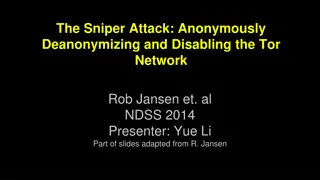
Network Security and Privacy with Tor: Overview, Uses, and Working
Explore how the Tor network enhances online privacy and security, allowing individuals and organizations to share information without compromising their privacy. Learn about the uses of Tor, why it is essential, how it works, and the types of relays involved in safeguarding online activities.
Download Presentation

Please find below an Image/Link to download the presentation.
The content on the website is provided AS IS for your information and personal use only. It may not be sold, licensed, or shared on other websites without obtaining consent from the author. If you encounter any issues during the download, it is possible that the publisher has removed the file from their server.
You are allowed to download the files provided on this website for personal or commercial use, subject to the condition that they are used lawfully. All files are the property of their respective owners.
The content on the website is provided AS IS for your information and personal use only. It may not be sold, licensed, or shared on other websites without obtaining consent from the author.
E N D
Presentation Transcript
CRYPTOGRAPHY AND NETWORK SECURITY Lecture slides by Davide Fusc and G. Ianni for the Network and Computer Security course at Universit della Calabria
OVERVIEW The Tor network is a group of volunteer-operated servers that allows people to improve their privacy and security on the Internet Tor's users employ this network by connecting through a series of virtual tunnels, thus allowing both organizations and individuals to share information over public networks without compromising their privacy
USES OF TOR Individuals use Tor to keep websites from tracking them and their family members, or when these are blocked by their local Internet providers Journalists use Tor to communicate more safely with whistleblowers and dissidents A branch of the U.S. Navy uses Tor for open source intelligence gathering, and one of its teams used Tor while deployed in the Middle East recently Law enforcement uses Tor for visiting or surveilling web sites without leaving government IP addresses in their web logs, and for security during sting operations
WHY WE NEED TOR Using Tor protects you against a traffic analysis Knowing the source and destination of your Internet traffic allows others to track your behavior and interests A basic problem for the privacy is that the recipient of your communications can see that you sent it by looking at headers. So can authorized intermediaries like Internet service providers Encryption does not help against these attackers, since it only hides the content of Internet traffic, not the headers.
TYPES OF RELAYS By default, Tor bounces connections through 3 relays: Entry/Guard Relay This is the entry point to the Tor network Middle Relay Used to transport traffic from the guard relay to the exit relay Exit Relay These relays are the exit point at the edge of the Tor network How do we know we can actually trust relays? How can we be sure relays won t track who we re connecting to and sniff the data we send across the wire?
WHY ONION How the encryption works when a client makes a connection through the Tor network: The client encrypts the original data in such a way that only the exit relay can decrypt it This encrypted data is then encrypted again in such a way that only the middle relay can decrypt it Finally, this encrypted data is encrypted once more in such a way that only the guard relay can decrypt it
WHY ONION This means that we have wrapped our original data in layers of encryption, much like an onion
STAYING ANONYMOUS Tor can't solve all anonymity problems Tor focuses only on protecting the transport of data You need to use protocol-specific support software if you don't want the sites you visit to see your identifying information: For example, you can use Tor Browser while browsing the web to withhold some information about your computer's configuration Also, to protect your anonymity, be smart: For example don't provide your name or other revealing information in web forms.
TRANSPARENT SOCKS Provides transparent network access through a SOCKS proxy TSocks intercepts the calls applications make to establish TCP connections and transparently proxies them as necessary Using tsocks configured with tor, any application that uses sockets can be made to use the socks proxy and become anonymous.
HIDDEN SERVICE Tor makes it possible for users to hide their locations while offering various kinds of services A hidden service needs to advertise its existence in the Tor network before clients will be able to contact it Therefore, the service randomly picks some relays, builds circuits to them, and asks them to act as introduction points by telling them its public key
TOR WEAKNESSES Traffic Analysis Traffic Confirmation Attack (July 4 2014) The attacker controls or observes the relays on both ends of a Tor circuit and then compares traffic timing, volume, or other characteristics to conclude that the two relays are indeed on the same circuit Sybil attack The attacker subverts the reputation system of a peer-to-peer network by creating a large number of pseudonymous identities
User Fingerprinting https://panopticlick.eff.org/ http://www.browserleaks.com/canvas http://browserspy.dk/






















